THE BEST HAMSTRING WORKOUTS FOR MASS & STRENGTH
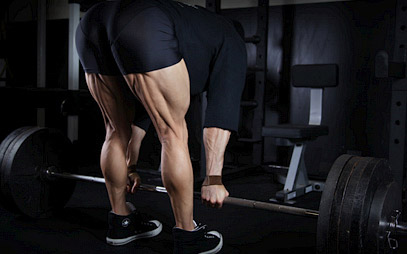
While you probably won’t hear too many women asking you to “flex your hamstring” for them, properly developed “leg biceps” are an important part of any well-rounded physique.
They also tend to be an underdeveloped muscle on most bodybuilders, as they’re often treated as an after-thought and are not trained with equal focus and intensity in comparison to other muscle groups.
If you want to learn a simple and straightforward method to build big hamstrings, keep reading…
How To Build Big Hamstrings
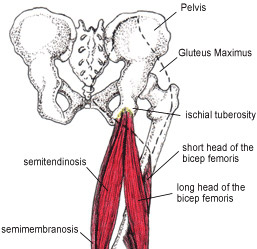
The hamstrings (properly referred to as the “biceps femorus”) are made up of 2 individual heads: the short head and the long head. These heads perform two basic functions:
1) Hip Extension – This is a compound movement where the hamstrings work in conjunction with the spinal erectors, glutes and adductors.
Examples of hip extension movements for the hamstrings are stiff legged deadlifts, good mornings and glute-ham raises.
2) Knee Flexion – This is an isolation movement where the hamstrings are the single primary muscle involved.
Examples of knee flexion movements are any type of leg curl, whether it be lying, seated or standing.
In order to build big hamstrings and structure a proper hamstring workout, you’ll want to select one exercise to target each of these specific movements.
Compound quad exercises like squats, lunges and leg presses definitely hit the hamstrings to a reasonable degree, but direct hamstring work is still a definite necessity if you want to maximize their development.
Exercise Selection For Your Hamstring Workout
Hip Extension Movement
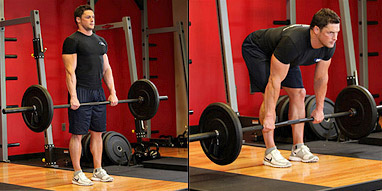
Just as you always want to perform your bench presses before flyes or squats before leg extensions, your hamstring workout should begin with a compound hip extension exercise as your primary movement.
If you perform your knee flexion exercise first, you end up “pre-exhausting” the hamstrings which actually decreases their activation during the hip extension movement.
This technique can be useful if you have lower back issues (since hip extensions place more stress on this area, and pre-exhausting allows you to perform the movement with less total resistance), but if you are otherwise healthy, always perform your hip extension movement first.
There are a few different choices here, but I would recommend a romanian deadlift as your core exercise (pictured above). This can be performed using either a barbell or dumbbells.
Either choice is fine, but keep in mind that the dumbbell variation allows you to target your hamstrings while taking some of the stress off of your lower back. This is because dumbbells allow you to hold the resistance more at your sides, whereas a barbell must be held out in front of your body.
Romanian deadlifts are a fantastic exercise to build big hamstrings, but make sure that your form is nailed down first before applying any real level of intensity. If you perform RDL’s incorrectly it can put your lower back in a very vulnerable position.
Always keep your knees slightly bent, lower back arched, barbell/dumbbells close to your body, butt pushed out, and only lower yourself until your torso is parallel to the ground.
If you are unable to perform RDL’s due to injury, use a glute-ham raise instead. Glute-ham raises are also a great exercise but allow you to hit the hamstrings hard with a relatively low amount of overall resistance.
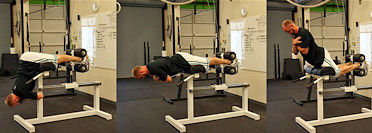
Knee Flexion Movement
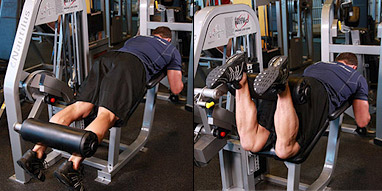
Your knee flexion exercise basically comes down to three choices: lying leg curls (pictured above), seated leg curls or standing leg curls.
Any variation is acceptable. I personally favor the lying leg curl, but you can try out any of the three and decide which is most comfortable for you.
Hamstring tears are not uncommon, so as with any exercise, always make sure you’re lifting with correct form. Select a weight for your leg curls that you can control at all times and that allows for a brief pause in the fully contracted position followed by a deliberate 3-4 second negative.
I would also recommend that you avoid fully extending your knee in the bottom position (stop a few inches short) as this will decrease the chances of a hamstring injury.
Build Big Hamstrings: Sets, Reps & Frequency
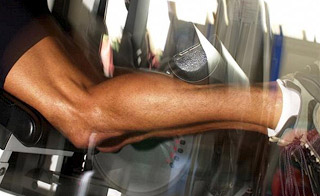
We’ve now established proper exercise selection to build big hamstrings, but what about the sets, reps and frequency for your hamstring workout?
Sets: The number of sets you perform will depend on your overall intensity level. As a general rule, go with 2-4 sets for each movement, for a total of 4-8 sets per workout. If you’re training to concentric muscular failure, 2 sets each will easily get the job done, whereas if you’re training a rep or two short of failure, go with the full 4 sets.
Reps: The hamstrings are a fast-twitch dominant muscle group, and for that reason they tend to respond better to a slightly lower rep range.
For the sake of overall safety I would recommend keeping your hip extension movements in the range of about 8-10, whereas the leg curl movements can go a bit lower, utilizing a range of around 5-7.
Frequency: As with all major muscle groups, you can perform a direct hamstring workout about once every 4-7 days depending on your individual recovery ability and training schedule.
How To Build Big Hamstrings: Quick Review
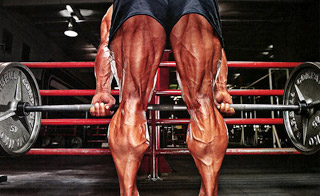
That’s really all you need to know when it comes to structuring an optimal workout in order to build big hamstrings.
Here’s a quick recap of what we covered…
1) Begin your hamstring workout with a compound hip extension exercise, with a barbell or dumbbell romanian deadlift being the ideal choice. If you have lower back issues, perform glute-ham raises instead.
2) Finish your hamstring workout with a knee flexion isolation exercise. This can be either lying leg curls, seated leg curls or standing leg curls depending on your preference.
3) Perform 2-4 sets for each exercise. If you’re training to failure then 2 sets is enough, and if you’re training with more moderate intensity then go with 4 sets.
4) Utilize 8-10 reps on hip extension exercises and about 5-7 reps on knee flexion exercises.
5) Perform a direct hamstring workout once every 4-7 days.
If you found this article helpful, make sure to sign up for your FREE custom fitness plan below...




